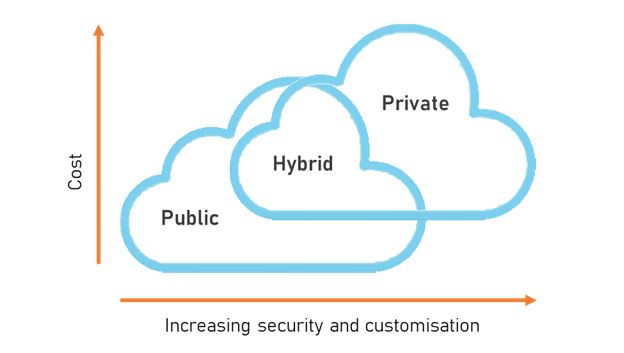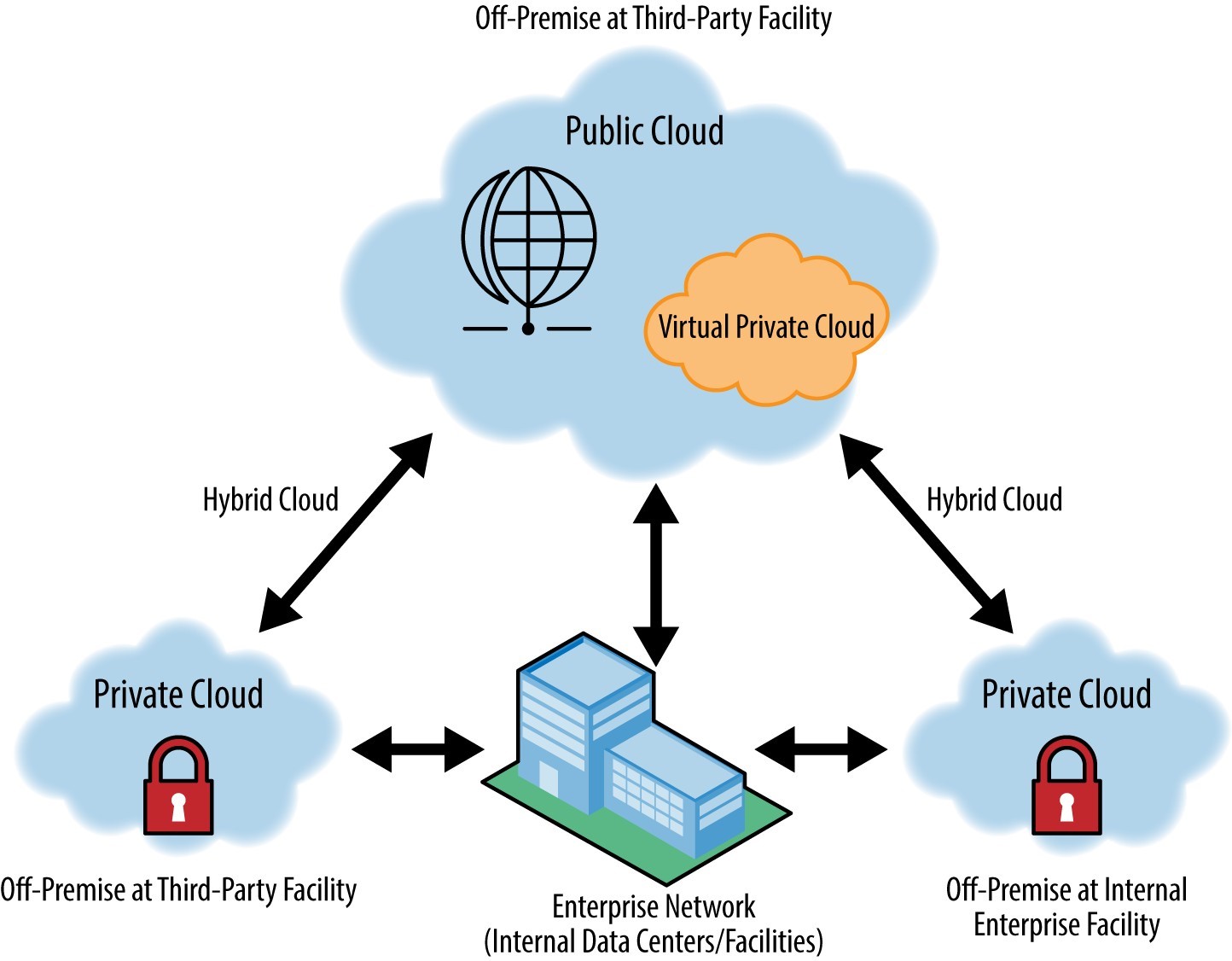What are Cloud Computing Models?
Cloud computing models refer to the various approaches to delivering and consuming computing resources and services over the internet. These models have become increasingly popular in the modern digital landscape due to their flexibility, scalability, and cost-effectiveness. The three main cloud computing models are public, private, and hybrid, each with its unique characteristics and benefits.
A public cloud model is where a third-party provider offers computing resources and services, such as storage, processing power, and applications, over the internet. The infrastructure and services are owned and managed by the provider, and users access them on a pay-per-use basis. Public clouds offer the benefits of low cost, scalability, and minimal maintenance.
In contrast, a private cloud model is where an organization builds and manages its own cloud infrastructure, either on-premises or off-premises. Private clouds offer greater control, security, and customization than public clouds. However, they require significant upfront investment and ongoing maintenance costs.
A hybrid cloud model combines both public and private cloud models, allowing organizations to leverage the benefits of both. Hybrid clouds offer the flexibility to scale up or down computing resources as needed, while maintaining control and security over sensitive data and applications.
When choosing a cloud computing model, organizations should consider factors such as cost, security, scalability, and compliance. A comprehensive assessment of the organization’s needs and objectives is essential to ensure the successful implementation of a cloud computing model. In the following sections, we will provide a step-by-step guide on how to choose the right cloud computing model for your business, and present real-life case studies of successful implementations.
Public, Private, and Hybrid Cloud Models: A Comparative Analysis
As discussed earlier, cloud computing models refer to the various approaches to delivering and consuming computing resources and services over the internet. The three main cloud computing models are public, private, and hybrid, each with its unique characteristics and benefits. In this section, we will compare and contrast these models, discussing the advantages and disadvantages of each, and when to use them.
Public cloud models are offered by third-party providers, who own and manage the infrastructure and services. These models offer the benefits of low cost, scalability, and minimal maintenance. However, they may not be suitable for organizations with strict security and compliance requirements, as data and applications are stored on shared infrastructure.
Private cloud models, on the other hand, offer greater control, security, and customization. These models are built and managed by the organization, either on-premises or off-premises. However, they require significant upfront investment and ongoing maintenance costs. Private clouds may be suitable for organizations with sensitive data and applications that require a high level of security and control.
Hybrid cloud models combine both public and private cloud models, allowing organizations to leverage the benefits of both. Hybrid clouds offer the flexibility to scale up or down computing resources as needed, while maintaining control and security over sensitive data and applications. However, they require careful planning and integration to ensure seamless operation and compatibility.
When choosing a cloud computing model, organizations should consider factors such as cost, security, scalability, and compliance. A comprehensive assessment of the organization’s needs and objectives is essential to ensure the successful implementation of a cloud computing model. In the following section, we will provide a step-by-step guide on how to choose the right cloud computing model for your business.
How to Choose the Right Cloud Computing Model for Your Business
Choosing the right cloud computing model for your business is a critical decision that requires careful consideration of various factors. In this section, we will provide a step-by-step guide on how to choose the right cloud computing model for your business, discussing factors such as cost, security, scalability, and compliance.
Step 1: Assess Your Business Needs
The first step in choosing the right cloud computing model is to assess your business needs. Consider factors such as the size of your organization, the nature of your workloads, and your budget. This will help you determine the resources and services you require, and the level of control and security you need.
Step 2: Evaluate Cloud Service Providers
Once you have assessed your business needs, the next step is to evaluate cloud service providers. Consider factors such as the provider’s reputation, experience, and track record. Look for providers that offer flexible and scalable solutions, and that have a strong focus on security and compliance.
Step 3: Consider Cost
Cost is an important factor when choosing a cloud computing model. Consider the cost of the services, as well as any additional costs such as data transfer fees, storage costs, and maintenance fees. Look for providers that offer transparent pricing and flexible payment options.
Step 4: Evaluate Security
Security is a critical factor when choosing a cloud computing model. Consider the provider’s security measures, such as encryption, access controls, and intrusion detection. Look for providers that offer a shared responsibility model, where both the provider and the customer are responsible for security.
Step 5: Consider Scalability
Scalability is an important factor when choosing a cloud computing model. Consider the provider’s ability to scale up or down resources as needed, and look for providers that offer flexible and scalable solutions.
Step 6: Evaluate Compliance
Compliance is a critical factor when choosing a cloud computing model. Consider the provider’s compliance with industry standards and regulations, such as HIPAA, PCI-DSS, and GDPR. Look for providers that offer compliance reports and certifications.
By following these steps, you can choose the right cloud computing model for your business, ensuring that you have the resources and services you need, while also maintaining control, security, and compliance.
Case Study: Successful Implementation of Cloud Computing Models
In this section, we will present a real-life case study of a business that has successfully implemented a cloud computing model. We will discuss the challenges faced and the solutions implemented, providing insights and best practices for businesses looking to adopt cloud computing.
Background
XYZ Corporation is a mid-sized manufacturing company that produces industrial equipment. With a growing customer base and increasing demand for its products, XYZ Corporation was facing challenges in managing its IT infrastructure and applications.
Challenges
XYZ Corporation was facing several challenges in managing its IT infrastructure and applications, including:
- High capital and operational costs
- Limited scalability and flexibility
- Complex disaster recovery and business continuity planning
- Security and compliance concerns
Solution
To address these challenges, XYZ Corporation decided to adopt a cloud computing model. The company worked with a cloud service provider to migrate its IT infrastructure and applications to the cloud. The solution included:
- Infrastructure as a Service (IaaS) for managing servers, storage, and networking
- Platform as a Service (PaaS) for developing and deploying applications
- Security and compliance services for protecting data and applications
- Disaster recovery and business continuity services for ensuring business resilience
Results
By adopting a cloud computing model, XYZ Corporation was able to achieve several benefits, including:
- Reduced capital and operational costs
- Increased scalability and flexibility
- Simplified disaster recovery and business continuity planning
- Improved security and compliance
The successful implementation of the cloud computing model has enabled XYZ Corporation to focus on its core business, while also ensuring the reliability, security, and scalability of its IT infrastructure and applications.
The Future of Cloud Computing Models: Trends and Predictions
Cloud computing models have revolutionized the way businesses operate, enabling them to scale their operations, reduce costs, and improve efficiency. As we look to the future, it is clear that cloud computing will continue to play a critical role in the digital landscape. In this section, we will discuss the future of cloud computing models and the trends and predictions in the industry.
Emerging Technologies
Emerging technologies such as artificial intelligence (AI), machine learning (ML), and the Internet of Things (IoT) are driving the adoption of cloud computing models. These technologies require vast amounts of computing power and data storage, making cloud computing an ideal solution. As these technologies continue to mature, we can expect to see an increase in the adoption of cloud computing models.
Multi-Cloud and Hybrid Cloud Strategies
Many businesses are adopting multi-cloud and hybrid cloud strategies to take advantage of the unique benefits of different cloud computing models. Multi-cloud strategies involve using multiple cloud providers, while hybrid cloud strategies involve using a combination of public and private cloud models. These strategies enable businesses to improve scalability, reduce costs, and improve disaster recovery capabilities.
Security and Compliance
Security and compliance will continue to be critical factors in the adoption of cloud computing models. As businesses move more of their operations to the cloud, they will need to ensure that their data is secure and compliant with regulations. Cloud service providers are investing heavily in security and compliance measures, such as encryption, access controls, and auditing capabilities, to meet these needs.
Sustainability
Sustainability is becoming an increasingly important factor in the adoption of cloud computing models. Cloud computing can help businesses reduce their carbon footprint by enabling them to use resources more efficiently. Cloud service providers are also investing in renewable energy and sustainable data centers to reduce their environmental impact.
Conclusion
The future of cloud computing models is bright, with emerging technologies, multi-cloud and hybrid cloud strategies, security and compliance, and sustainability driving adoption. As businesses continue to move their operations to the cloud, they will need to carefully consider their cloud computing model to ensure that they are taking advantage of the unique benefits of each model while also addressing security, compliance, and sustainability concerns.
Security Considerations in Cloud Computing Models
Cloud computing models have become increasingly popular in recent years, offering businesses a range of benefits including cost savings, scalability, and flexibility. However, as with any technology, security is a critical consideration. In this section, we will discuss the security considerations in cloud computing models, including the shared responsibility model and best practices for securing data in the cloud.
Shared Responsibility Model
One of the key security considerations in cloud computing models is the shared responsibility model. This model outlines the respective responsibilities of the cloud service provider and the customer when it comes to security. In general, the cloud service provider is responsible for securing the underlying infrastructure, while the customer is responsible for securing their applications and data.
Best Practices for Securing Data in the Cloud
To ensure the security of their data in the cloud, businesses should follow best practices including:
- Encrypting data both in transit and at rest
- Implementing access controls and multi-factor authentication
- Regularly backing up data and testing disaster recovery plans
- Monitoring cloud usage and activity for suspicious behavior
- Implementing security policies and procedures
Conclusion
Security is a critical consideration in cloud computing models. By understanding the shared responsibility model and following best practices for securing data in the cloud, businesses can ensure the security and integrity of their data while taking advantage of the benefits of cloud computing.
Cloud Computing Models and Disaster Recovery
Disasters can strike at any time, causing unexpected disruptions to businesses. Cloud computing models can play a critical role in disaster recovery, enabling businesses to quickly recover their data and applications in the event of an outage or disaster. In this section, we will discuss the role of cloud computing models in disaster recovery and how businesses can leverage these models to ensure business continuity.
Benefits of Cloud Computing Models for Disaster Recovery
Cloud computing models offer several benefits for disaster recovery, including:
- Scalability: Cloud computing models offer scalable resources, enabling businesses to quickly scale up their computing resources in the event of a disaster.
- Cost-effectiveness: Cloud computing models can be more cost-effective than traditional disaster recovery solutions, as businesses only pay for the resources they use.
- Reliability: Cloud computing models offer high availability and reliability, ensuring that businesses can quickly recover their data and applications in the event of an outage or disaster.
Best Practices for Cloud Computing Disaster Recovery
To ensure a successful disaster recovery plan using cloud computing models, businesses should follow best practices including:
- Regularly backing up data and applications to the cloud
- Testing disaster recovery plans regularly
- Implementing multi-region deployments for added redundancy
- Using cloud-native disaster recovery tools and services
Conclusion
Cloud computing models can play a critical role in disaster recovery, enabling businesses to quickly recover their data and applications in the event of an outage or disaster. By following best practices and leveraging the scalability, cost-effectiveness, and reliability of cloud computing models, businesses can ensure business continuity and minimize the impact of disruptions.
Cloud Computing Models and Sustainability
In today’s world, sustainability is becoming an increasingly important consideration for businesses. Cloud computing models can play a significant role in promoting sustainability, helping businesses reduce their carbon footprint and contribute to a more sustainable future. In this section, we will discuss the sustainability benefits of cloud computing models and how businesses can leverage these models to promote sustainability.
Reducing Carbon Footprint with Cloud Computing Models
Cloud computing models can help businesses reduce their carbon footprint in several ways, including:
- Reducing energy consumption: Cloud computing providers typically use highly efficient data centers that consume less energy than traditional on-premises data centers.
- Optimizing resource utilization: Cloud computing models enable businesses to optimize their resource utilization, reducing waste and conserving resources.
- Promoting remote work: Cloud computing models enable remote work, reducing the need for commuting and contributing to lower carbon emissions.
Best Practices for Promoting Sustainability with Cloud Computing Models
To promote sustainability with cloud computing models, businesses should follow best practices including:
- Choosing a cloud computing provider with a strong commitment to sustainability
- Optimizing resource utilization and reducing waste
- Promoting remote work and reducing commuting
- Monitoring and reporting on carbon emissions and sustainability metrics
Conclusion
Cloud computing models can play a significant role in promoting sustainability, helping businesses reduce their carbon footprint and contribute to a more sustainable future. By following best practices and choosing a cloud computing provider with a strong commitment to sustainability, businesses can leverage the benefits of cloud computing models to promote sustainability and reduce their environmental impact.






